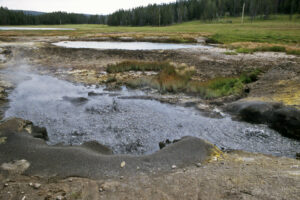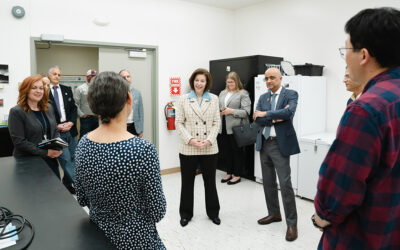DRI contributes to international team of scientists that unearths first in-depth look at Omnitrophota, one of the world’s oldest and tiniest bacteria
DRI’s Duane Moser, Ph.D., is a coauthor on a new study in Nature Microbiology that offers the first detailed analysis of a globally prominent, but poorly characterized type of bacteria belonging to a group scientists refer to as “microbial dark matter.” Formally described here for the first time as the Omnitrophota, the existence of this phylum of bacteria was first inferred from environmental DNA nearly thirty years ago.
“This paper illuminates the properties and ecological function of a group of ubiquitous, but poorly understood organisms,” said Moser, associate research professor of microbiology.
Moser’s contribution to the study included identifying field sites and collecting samples, as well as developing an understanding of environmental context. His long-standing research relationship with the lead authors of the study meant that collaborative projects over the years led to a number of useful datasets for the analysis.
“The research community has followed the Omnitrophota story since the 1990s, when earlier groundbreaking studies that revealed unexpected diversity within Archaea at Obsidian Pool in Yellowstone National Park were expanded to include bacteria,” Moser says. “In those days, full genomes of uncultivable microorganisms were beyond the reach of available technologies, so a conserved gene that encodes an essential structure shared by all cellular life (the 16S rRNA gene) was used to identify novel life and estimate relatedness between organisms.”

Photo: Obsidian Pool in Yellowstone National Park. Credit: Bob Lindstrom. Photo in the Public Domain.
“What scientists found was so different from anything that had been described previously that scientists of the time proposed that Omnitrophota might be a novel phylum within Bacteria (the equivalent of the evolutionary difference between plants and animals). This interpretation has stood the test of time,” Moser continued.
“Over the past several decades, Omnitrophota has been frequently encountered in aquatic and soil samples worldwide. In our own work in springs, mines, and shallow groundwaters, Omnitrophota have often been among the more prominent microbial groups detected. I sometimes wonder if the sheer abundance and evident diversity of this omnipresent group has intimidated researchers from tackling its formal description. This was an ambitious project that required the combined expertise of a strong team of collaborators.”
Brian Hedlund, a microbiologist at the University of Nevada, Las Vegas, and lead author of the study, said “Duane’s knowledge of the geology and hydrology of subsurface environments — and how to sample them meaningfully — was really important for this study.”
Below is the full press release from the University of Nevada, Las Vegas.
LAS VEGAS – March 16, 2023 – Bacteria are literally everywhere – in oceans, in soils, in extreme environments like hot springs, and even alongside and inside other organisms including humans. They’re nearly invisible, yet they play a big role in almost every facet of life on Earth.
Despite their abundance, surprisingly little is known about many microorganisms that have existed for billions of years.
This includes an entire lineage of nano-sized bacteria dubbed Omnitrophota. These bacteria, first discovered based on short fragments of DNA just 25 years ago, are common in many environments around the world but have been poorly understood. Until now.
An international research team produced the first large-scale analysis of more than 400 newly sequenced and existing Omnitrophota genomes, uncovering new details about their biology and behavior. The team’s findings are reported in the March 16 issue of the journal Nature Microbiology.
“We now have the most comprehensive view to date of the biology of an entire phylum of microorganisms and the surprising role they play in the Earth’s ecosystems,” said UNLV microbiologist Brian Hedlund, the study’s corresponding author. “There is a finite number of major lineages of life on our planet, and it’s exciting to learn more about organisms that pre-date plants and animals and have been essentially hidden under our noses.”
The tricky thing with Omnitrophota is that they’re still largely considered microbial dark matter, which means they exist in nature but can’t yet be cultivated as single species in lab studies. Just two species have been microscopically observed, and only very recently.
To present a comprehensive picture of their biology, scientists compared 349 existing and 72 newly mapped genomes of Omnitrophota. This included a review of publicly available data and new samples collected from geothermal environments, freshwater lakes, wastewater, groundwater, and springs located around the world.
The team observed that, in most cases, Omnitrophota measure less than 450 nanometers, which places them among the smallest of all known organisms. They also displayed genetic markers consistent with symbiosis – possibly as predators or parasites of other microorganisms, which suggested they would have high metabolic rates. Indeed, when isotope uptake was measured as a proxy for metabolic activity, Omnitrophota were hyperactive.
“Despite how little we collectively knew about Omnitrophota, they’ve long been cited by microbial ecologists. Our goal was to finally drag this lineage out of the dark,” said Cale Seymour, a recent UNLV master’s graduate and the study’s lead author. “The more we learn about their energy conservation pathways and possible lifestyles, the closer we get to our goal of cultivating them in the lab and bringing them into the light.”
The study, “Hyperactive nanobacteria with host-dependent traits pervade Omnitrophota,” appeared March 16 in the journal Nature Microbiology. Additional collaborating organizations include Bigelow Laboratory for Ocean Sciences, the University of North Alabama, the U.S. Department of Energy’s Joint Genome Institute, Desert Research Institute, Northern Arizona University, Sun Yat-sen University, University of Science and Technology of China, and University of Queensland.


